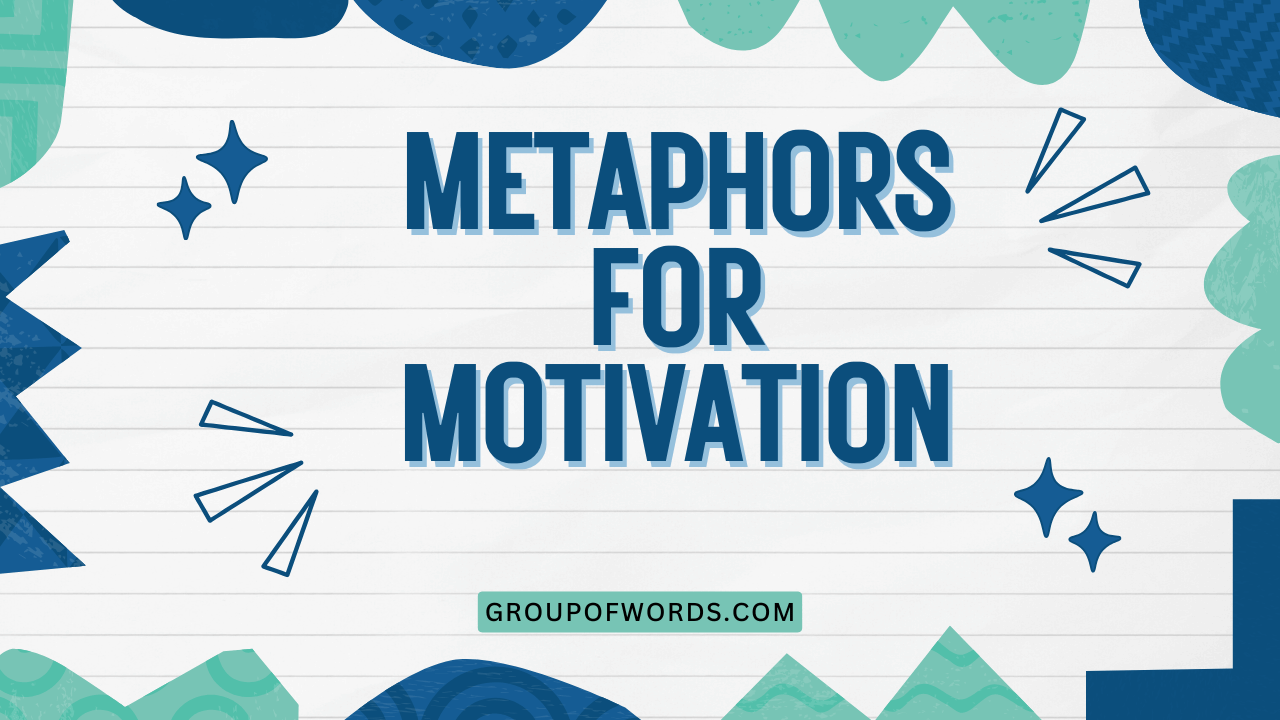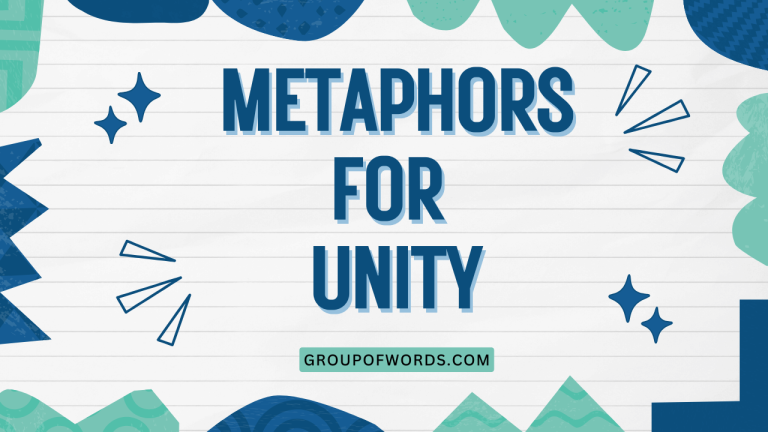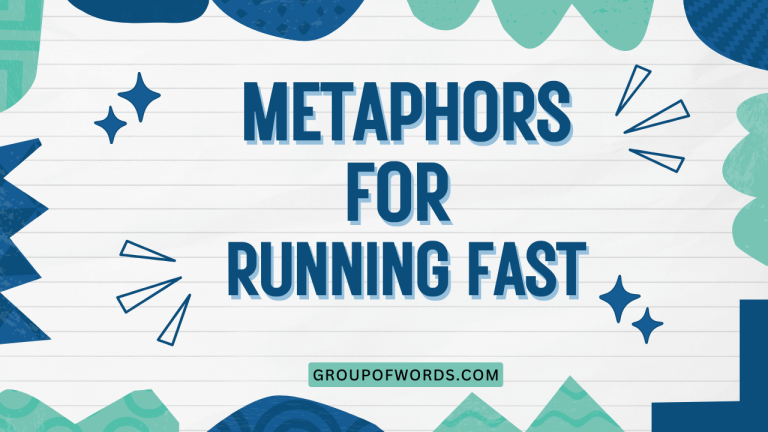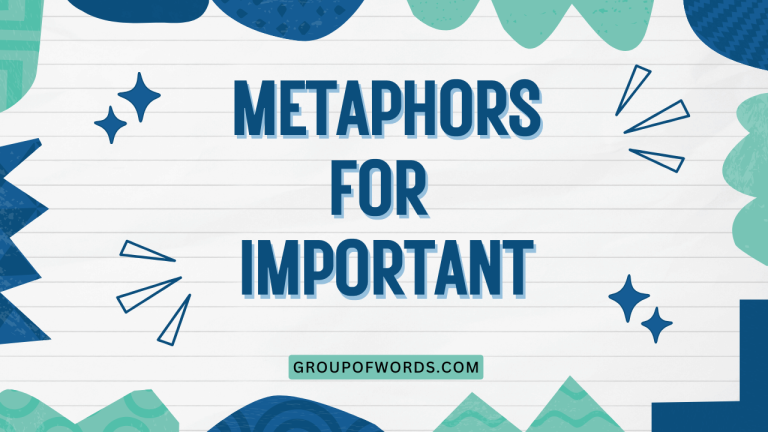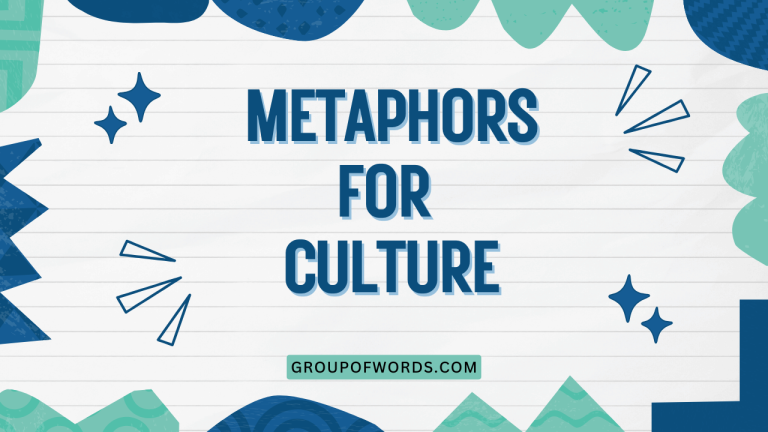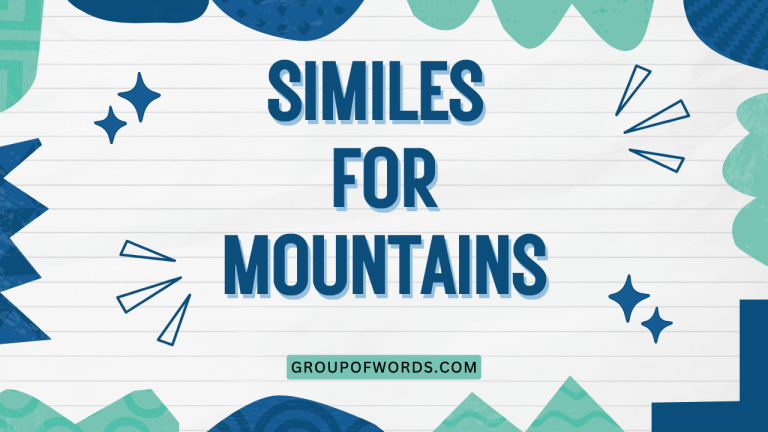Metaphors for Motivation: Inspiring Language
Understanding and using metaphors for motivation can significantly enhance your communication skills and inspire action in yourself and others. This article delves into the world of motivational metaphors, exploring their structure, types, and effective usage.
Whether you’re a student, professional, or simply interested in the power of language, this guide will equip you with the knowledge to harness metaphors for increased motivation and impact.
Table of Contents
- Introduction
- Definition of Metaphor for Motivation
- Structural Breakdown of Motivational Metaphors
- Types of Metaphors for Motivation
- Examples of Metaphors for Motivation
- Usage Rules for Motivational Metaphors
- Common Mistakes with Motivational Metaphors
- Practice Exercises
- Advanced Topics in Motivational Metaphors
- FAQ: Metaphors for Motivation
- Conclusion
Definition of Metaphor for Motivation
A metaphor for motivation is a figure of speech that compares one thing to another, unrelated thing to inspire or encourage action. Unlike similes, which use “like” or “as,” metaphors directly state that one thing *is* another.
The goal is to transfer the qualities or associations of the second thing (the metaphorical term) to the first (the topic) to create a more vivid and compelling message. These metaphors often tap into universal human experiences and emotions, making them powerful tools for leadership, personal development, and communication.
The function of a motivational metaphor is to reframe a situation or goal in a way that makes it seem more attainable, desirable, or urgent. By using imaginative language, these metaphors can bypass rational objections and connect with people on an emotional level, sparking their intrinsic motivation.
They provide a new perspective, making the abstract feel concrete and the daunting feel manageable. The context in which a motivational metaphor is used is crucial.
The effectiveness of the metaphor depends on the audience, the situation, and the speaker’s intention.
Structural Breakdown of Motivational Metaphors
Motivational metaphors, like all metaphors, consist of two primary elements: the **topic** and the **vehicle**. The topic is the subject being discussed, the thing you want to motivate someone about.
The vehicle is the metaphorical term used to describe the topic, carrying with it connotations and associations that influence perception. Understanding how these elements interact is key to crafting effective motivational metaphors.
The structure is often implicit. The connection between the topic and vehicle isn’t explicitly stated but implied through the language used.
For instance, saying “This project is a marathon, not a sprint” implies that the project (topic) requires endurance and pacing, similar to a marathon (vehicle). The implied meaning is crucial for the metaphor to resonate.
The effectiveness of a metaphor hinges on the audience’s ability to recognize and understand the connection between the topic and the vehicle.
Types of Metaphors for Motivation
Motivational metaphors can be categorized based on the source domain they draw from. Here are some common types:
Journey Metaphors
Journey metaphors frame achieving a goal as a journey, emphasizing progress, obstacles, and the final destination. These metaphors often invoke feelings of adventure, perseverance, and accomplishment.
Example: “The road to success is paved with hard work.”
War Metaphors
War metaphors use the language of conflict and battle to highlight the challenges and the need for strategic action. These metaphors can be highly motivating in competitive environments, but need to be used with caution to avoid promoting aggression.
Example: “We need to attack this problem head-on.”
Sports Metaphors
Sports metaphors draw parallels between achieving goals and winning in sports. They emphasize teamwork, discipline, and the pursuit of excellence.
Example: “Let’s huddle up and plan our next play.”
Building Metaphors
Building metaphors represent progress as the construction of a structure, emphasizing planning, foundation, and gradual growth. These metaphors are effective for conveying the importance of a solid strategy and incremental steps.
Example: “We’re laying the foundation for future success.”
Light and Darkness Metaphors
Light and darkness metaphors associate goals with light (clarity, hope, enlightenment) and challenges with darkness (uncertainty, fear, ignorance). These metaphors can evoke strong emotional responses and inspire a quest for understanding and improvement.
Example: “Let’s shed some light on this issue.”
Examples of Metaphors for Motivation
Here are several tables providing a wide array of motivational metaphors, categorized for easy reference.
The following table showcases journey metaphors, illustrating how they can be used to frame goals as adventures and challenges as obstacles on a path.
| Category | Metaphor | Explanation |
|---|---|---|
| Journey | “The path to success isn’t always a straight line.” | Implies there will be detours and challenges. |
| Journey | “We’re navigating uncharted waters.” | Suggests exploration and the need for adaptability. |
| Journey | “This is a marathon, not a sprint.” | Emphasizes endurance and pacing. |
| Journey | “Every step forward is a victory.” | Highlights the importance of progress, no matter how small. |
| Journey | “We’re climbing a steep mountain, but the view from the top will be worth it.” | Acknowledges difficulty while promising a rewarding outcome. |
| Journey | “The journey of a thousand miles begins with a single step.” | Encourages taking the first step, no matter how daunting the overall goal seems. |
| Journey | “We’re on a quest to find the best solution.” | Frames the task as an exciting adventure. |
| Journey | “Don’t get bogged down in the swamp of details.” | Warns against being overwhelmed by minor issues. |
| Journey | “We’re paving the way for future generations.” | Suggests a lasting impact. |
| Journey | “Let’s stay the course.” | Encourages perseverance and not giving up. |
| Journey | “We’re at a crossroads; which path will we choose?” | Highlights a critical decision point. |
| Journey | “The road may be bumpy, but we’ll get there.” | Acknowledges difficulties but assures eventual success. |
| Journey | “We’re charting a new course.” | Implies innovation and breaking new ground. |
| Journey | “This is a long and winding road.” | Suggests a challenging but ultimately rewarding journey. |
| Journey | “We need to pack our bags for this adventure.” | Encourages preparation and readiness. |
| Journey | “Let’s keep our eyes on the horizon.” | Focuses on the long-term goal. |
| Journey | “We’re navigating through a maze of regulations.” | Highlights the complexity of the situation. |
| Journey | “The path ahead is clear.” | Suggests a straightforward approach. |
| Journey | “Let’s avoid the pitfalls along the way.” | Warns against potential dangers. |
| Journey | “We’re reaching the summit of our goals.” | Indicates nearing completion and success. |
This table presents war metaphors, which can be useful for rallying people around a common cause or overcoming significant obstacles. However, it is important to use these metaphors responsibly and avoid creating a hostile or aggressive environment.
| Category | Metaphor | Explanation |
|---|---|---|
| War | “We need to attack this problem head-on.” | Suggests a direct and forceful approach. |
| War | “Let’s defend our market share.” | Emphasizes protecting current gains. |
| War | “This is a battle we can win.” | Instills confidence and determination. |
| War | “We need to be on the offensive.” | Encourages proactive action. |
| War | “Let’s strategize our next move.” | Highlights the importance of planning. |
| War | “We’re fighting an uphill battle.” | Acknowledges the difficulty of the challenge. |
| War | “Let’s take aim at our goals.” | Focuses on precision and accuracy. |
| War | “We need to reinforce our defenses.” | Emphasizes strengthening vulnerabilities. |
| War | “This is a war of attrition.” | Suggests a long and drawn-out struggle. |
| War | “We need to mobilize our resources.” | Encourages gathering all available support. |
| War | “Let’s launch a counter-attack.” | Suggests responding to a challenge aggressively. |
| War | “We need to be vigilant and defend our position.” | Emphasizes the importance of constant awareness. |
| War | “This is a strategic victory.” | Highlights the importance of planning and execution. |
| War | “We must conquer our fears.” | Encourages overcoming personal obstacles. |
| War | “Let’s break through the barriers.” | Suggests overcoming obstacles with force. |
| War | “We’re ready to charge forward.” | Implies a bold and energetic approach. |
| War | “Let’s not surrender to negativity.” | Encourages maintaining a positive attitude. |
| War | “We need to outmaneuver the competition.” | Emphasizes strategic thinking and agility. |
| War | “Let’s fortify our strengths.” | Encourages building upon existing skills and resources. |
| War | “We’re in the trenches, but we’ll get through it.” | Acknowledges a difficult situation but assures resilience. |
| War | “We’re ready to fight for our success.” | Demonstrates a strong commitment to achieving goals. |
Sports metaphors are presented in this table. These metaphors are effective in fostering teamwork, discipline, and a competitive spirit.
They can be particularly motivating for individuals who are passionate about sports.
| Category | Metaphor | Explanation |
|---|---|---|
| Sports | “Let’s huddle up and plan our next play.” | Encourages teamwork and strategic planning. |
| Sports | “We need to step up our game.” | Suggests improving performance. |
| Sports | “Let’s knock it out of the park.” | Encourages exceptional achievement. |
| Sports | “We need to stay focused on the ball.” | Emphasizes concentration and avoiding distractions. |
| Sports | “Let’s give it 110%.” | Encourages maximum effort. |
| Sports | “We’re in the home stretch.” | Indicates nearing completion. |
| Sports | “Let’s not drop the ball.” | Warns against making mistakes. |
| Sports | “We need to play as a team.” | Emphasizes collaboration. |
| Sports | “Let’s set a new personal best.” | Encourages individual improvement. |
| Sports | “We need to train harder to win.” | Highlights the importance of preparation. |
| Sports | “Let’s pass the baton smoothly.” | Emphasizes effective handover and collaboration. |
| Sports | “We need to be agile and quick on our feet.” | Highlights the importance of adaptability. |
| Sports | “This is a marathon, not a sprint.” | Emphasizes endurance and pacing. |
| Sports | “We’re playing on a level playing field.” | Suggests a fair and equal opportunity. |
| Sports | “Let’s aim for the gold.” | Encourages striving for the highest achievement. |
| Sports | “We need to be strategic in our plays.” | Emphasizes the importance of planning. |
| Sports | “Let’s stay ahead of the curve.” | Encourages innovation and progress. |
| Sports | “We need to build momentum.” | Highlights the importance of continuous progress. |
| Sports | “Let’s keep our eye on the prize.” | Maintains focus on the ultimate goal. |
| Sports | “We’re in the final inning.” | Indicates nearing the end of a project or task. |
| Sports | “We need to rally the troops.” | Encourages uniting and motivating the team. |
This table provides examples of building metaphors, which are particularly effective for illustrating the importance of planning, a strong foundation, and gradual progress. These metaphors can help individuals visualize their goals as something tangible and achievable through careful construction.
| Category | Metaphor | Explanation |
|---|---|---|
| Building | “We’re laying the foundation for future success.” | Emphasizes the importance of a strong base. |
| Building | “Let’s build this project from the ground up.” | Suggests a complete and thorough approach. |
| Building | “We need to construct a solid plan.” | Highlights the importance of careful planning. |
| Building | “Let’s build bridges, not walls.” | Encourages collaboration and connection. |
| Building | “We’re building a legacy.” | Suggests a lasting impact. |
| Building | “Let’s create a strong framework.” | Emphasizes the importance of structure. |
| Building | “We need to reinforce the pillars of our organization.” | Highlights the importance of core values and principles. |
| Building | “Let’s build a better future together.” | Encourages collective effort. |
| Building | “We’re constructing a sustainable business model.” | Emphasizes long-term viability. |
| Building | “Let’s build upon our past successes.” | Encourages learning from previous achievements. |
| Building | “We’re architects of our own destiny.” | Empowers individuals to shape their future. |
| Building | “Let’s erect a monument to our achievements.” | Suggests celebrating success and creating a lasting symbol. |
| Building | “We’re scaffolding new ideas.” | Highlights the support and structure needed for innovation. |
| Building | “Let’s build a consensus.” | Encourages agreement and collaboration. |
| Building | “We’re constructing a robust system.” | Emphasizes the importance of resilience and strength. |
| Building | “Let’s build a strong team.” | Encourages teamwork and collaboration. |
| Building | “We need to shore up our defenses.” | Highlights the importance of protecting against threats. |
| Building | “Let’s build a foundation of trust.” | Emphasizes the importance of honesty and reliability. |
| Building | “We’re constructing a brighter tomorrow.” | Inspires hope and optimism. |
| Building | “Let’s build a community of support.” | Encourages mutual aid and encouragement. |
| Building | “We are the building blocks of our company.” | Emphasizes the importance of each individual’s contribution. |
The following table presents light and darkness metaphors. These metaphors are useful for inspiring hope, clarity, and understanding, while also acknowledging and addressing challenges and uncertainties.
| Category | Metaphor | Explanation |
|---|---|---|
| Light/Darkness | “Let’s shed some light on this issue.” | Suggests clarifying a complex situation. |
| Light/Darkness | “We need to illuminate the path forward.” | Encourages providing guidance and direction. |
| Light/Darkness | “Let’s banish the shadows of doubt.” | Encourages overcoming uncertainty and fear. |
| Light/Darkness | “We’re moving from darkness into the light.” | Suggests progress from a difficult situation to a better one. |
| Light/Darkness | “Let’s bring clarity to the situation.” | Emphasizes the importance of understanding. |
| Light/Darkness | “We need to shine a spotlight on this success.” | Encourages recognition and celebration. |
| Light/Darkness | “Let’s dispel the myths surrounding this topic.” | Emphasizes uncovering the truth. |
| Light/Darkness | “We’re facing the darkness, but we’ll find the light.” | Acknowledges challenges but promises hope. |
| Light/Darkness | “Let’s ignite the spark of innovation.” | Encourages creativity and new ideas. |
| Light/Darkness | “We need to illuminate the potential.” | Highlights the possibilities for growth and success. |
| Light/Darkness | “Let’s cast a shadow on unethical practices.” | Encourages exposing and condemning wrongdoing. |
| Light/Darkness | “We’re walking towards the dawn of a new era.” | Suggests a promising future. |
| Light/Darkness | “Let’s shed light on the truth.” | Emphasizes honesty and transparency. |
| Light/Darkness | “We need to emerge from the shadows.” | Encourages stepping forward and taking action. |
| Light/Darkness | “Let’s brighten the future.” | Inspires optimism and hope. |
| Light/Darkness | “We’re chasing away the darkness with knowledge.” | Highlights the power of education and understanding. |
| Light/Darkness | “Let’s bring the issue into the light.” | Encourages open discussion and transparency. |
| Light/Darkness | “We need to be a beacon of hope.” | Inspires others and provides guidance. |
| Light/Darkness | “Let’s not let negativity cloud our vision.” | Encourages maintaining a positive attitude. |
| Light/Darkness | “We’re illuminating the path to success.” | Provides guidance and direction for achieving goals. |
| Light/Darkness | “We are the light in the darkness.” | Emphasizes the importance of hope and guidance in difficult times. |
Usage Rules for Motivational Metaphors
Effective use of motivational metaphors requires careful consideration of several factors. First, ensure the metaphor is relevant to your audience. A metaphor that resonates with one group may fall flat with another. Second, keep the metaphor consistent. Mixing metaphors can confuse your message. Third, avoid clichés. Overused metaphors lose their impact. Fourth, be mindful of cultural sensitivities. Some metaphors may have unintended negative connotations in certain cultures.
Fifth, consider the context. The appropriateness of a metaphor depends on the situation. A war metaphor might be suitable for a competitive sales environment but inappropriate for a team-building exercise. Sixth, use metaphors sparingly. Overusing metaphors can make your communication sound artificial and forced. Seventh, ensure clarity. The connection between the topic and the vehicle should be clear and easily understood. Eighth, be authentic. Your metaphors should reflect your genuine beliefs and values.
Common Mistakes with Motivational Metaphors
One common mistake is mixing metaphors. This occurs when you combine two or more unrelated metaphors, creating a confusing and nonsensical image. For example, saying “Let’s grab the bull by the horns and nip it in the bud” combines two different idioms that don’t logically fit together.
Another mistake is using clichéd metaphors. These are overused metaphors that have lost their impact and can make your communication sound unoriginal. Examples include “thinking outside the box” and “going the extra mile.”
A further error is using metaphors that are culturally insensitive or inappropriate for the context. It’s important to be aware of the potential connotations of your metaphors and ensure they are respectful and relevant to your audience.
Here’s a table illustrating common mistakes with motivational metaphors and providing corrections:
| Incorrect | Correct | Explanation |
|---|---|---|
| “Let’s grab the bull by the horns and nip it in the bud.” | “Let’s address this challenge directly and decisively.” | Avoids mixing metaphors. |
| “We need to think outside the box.” | “We need to explore unconventional solutions.” | Avoids using a cliché. |
| “This project is a cakewalk.” (To someone who dislikes cake) | “This project should be relatively straightforward.” | Ensures relevance to the audience. |
| “Let’s burn the midnight oil to reach the finish line.” | “Let’s work diligently to complete this project on time.” | Avoids overused idioms while maintaining the message. |
| “We’re all in the same boat, so let’s put our noses to the grindstone.” | “We’re all working together, so let’s dedicate ourselves to this task.” | Replaces mixed metaphors with a more coherent expression. |
| “This is a slam dunk; we’ll have it in the bag in no time.” | “This is a straightforward task; we’ll complete it quickly.” | Substitutes overused sports idioms with plain language. |
| “We need to go the extra mile and hit the ground running.” | “We need to exceed expectations and start immediately with enthusiasm.” | Replaces multiple clichés with a clear, direct statement. |
| “Let’s not reinvent the wheel; we’ll just add fuel to the fire.” | “Let’s build upon existing solutions and focus on improvements.” | Replaces contradictory idioms with a cohesive idea. |
| “This is a piece of cake; we’ll kill two birds with one stone.” | “This is an easy task; we’ll accomplish multiple goals at once.” | Avoids clichés and potentially offensive metaphors. |
| “We need to bite the bullet and then open a can of worms.” | “We need to face the initial difficulty and then address the subsequent complexities.” | Replaces conflicting idioms with a logical sequence. |
Practice Exercises
Test your understanding of motivational metaphors with these exercises.
Exercise 1: Identify the Metaphor
Identify the metaphor in each of the following sentences:
| Question | Answer |
|---|---|
| 1. “This project is a marathon, not a sprint.” | Marathon |
| 2. “We need to attack this problem head-on.” | Attack |
| 3. “Let’s huddle up and plan our next play.” | Huddle |
| 4. “We’re laying the foundation for future success.” | Foundation |
| 5. “Let’s shed some light on this issue.” | Light |
| 6. “The path to success is paved with hard work.” | Paved |
| 7. “We need to defend our market share.” | Defend |
| 8. “Let’s step up our game.” | Game |
| 9. “Let’s build bridges, not walls.” | Bridges and Walls |
| 10. “We’re moving from darkness into the light.” | Darkness and Light |
Exercise 2: Complete the Metaphor
Complete the following sentences with an appropriate motivational metaphor:
| Question | Answer |
|---|---|
| 1. “This challenge is a ________, but we can overcome it.” | Mountain |
| 2. “Let’s ________ and achieve our goals.” | Stay the course |
| 3. “We need to ________ to succeed.” | Play as a team |
| 4. “Our plan is the ________ for our success.” | Blueprint |
| 5. “Let’s ________ and find the best solution.” | Dig deeper |
| 6. “The journey is a long ________, but we will get there.” | Road |
| 7. “We need to ________ our strengths.” | Fortify |
| 8. “Let’s ________ and reach new heights.” | Aim higher |
| 9. “Our team is the ________ of our success.” | Backbone |
| 10. “We need to ________ to the task at hand.” | Apply ourselves |
Exercise 3: Create Your Own Metaphor
Create a motivational metaphor for each of the following situations:
| Situation | Metaphor |
|---|---|
| 1. Motivating a team to meet a tight deadline. | “We’re in the final lap; let’s push through to the finish line.” |
| 2. Encouraging a student to persevere through a difficult course. | “This course is a challenging climb, but the view from the summit is worth it.” |
| 3. Inspiring employees to embrace change. | “Change is the wind in our sails; let’s harness it to move forward.” |
| 4. Motivating a sales team to exceed their targets. | “Let’s break through the ceiling and reach for the stars.” |
| 5. Encouraging a group to collaborate effectively. | “We’re all pieces of the puzzle; let’s fit together perfectly to create the whole picture.” |
| 6. Motivating a team to innovate. | “We’re explorers charting new territories; let’s discover uncharted lands.” |
| 7. Encouraging persistence in the face of setbacks. | “Every stumble is a stepping stone; let’s use them to build our staircase to success.” |
| 8. Inspiring confidence in taking on a new challenge. | “This is our launchpad; let’s ignite the engines and soar to new heights.” |
| 9. Motivating a team to improve their communication. | “Our words are the bridges we build; let’s ensure they are strong and clear.” |
| 10. Encouraging a team to learn from their mistakes. | “Mistakes are our compass; let’s use them to navigate towards the right direction.” |
Advanced Topics in Motivational Metaphors
At an advanced level, the study of motivational metaphors delves into the cognitive and psychological underpinnings of their effectiveness. This includes understanding how metaphors activate specific neural pathways and influence emotional responses.
Advanced learners also explore the ethical considerations of using metaphors for persuasion, particularly in leadership and marketing contexts. It is crucial to consider how metaphors can be used to manipulate or mislead, and to develop a critical awareness of their potential impact.
Another advanced topic is the creation of novel and original metaphors. This requires a deep understanding of language, culture, and human psychology.
Advanced learners practice crafting metaphors that are not only memorable and evocative but also deeply meaningful and relevant to the specific audience and situation. This involves experimenting with different source domains and exploring unconventional connections between ideas.
Additionally, advanced learners study the use of extended metaphors, which are metaphors that are developed and elaborated throughout a text or speech to create a cohesive and compelling narrative. Mastering extended metaphors requires careful planning and attention to detail, ensuring that the metaphor remains consistent and impactful throughout the entire message.
FAQ: Metaphors for Motivation
Here are some frequently asked questions about metaphors for motivation:
Q1: What is the difference between a metaphor and a simile?
A: Both metaphors and similes are figures of speech that compare two different things. However, a metaphor directly states that one thing *is* another (e.g., “He is a lion”), while a simile uses “like” or “as” to make the comparison (e.g., “He is as brave as a lion”). Metaphors are generally considered more powerful and evocative.
Q2: How can I make my metaphors more effective?
A: To make your metaphors more effective, ensure they are relevant to your audience, consistent, and original. Avoid clichés and be mindful of cultural sensitivities. Consider the context and use metaphors sparingly. Clarity and authenticity are also crucial for creating a lasting impact.
Q3: What are some potential pitfalls to avoid when using metaphors?
A: Common pitfalls include mixing metaphors, using clichés, and employing metaphors that are culturally insensitive or inappropriate for the context. Be mindful of these potential issues to ensure your metaphors are clear, relevant, and respectful.
Q4: Can metaphors be used in all situations?
A: While metaphors can be powerful tools, they are not always appropriate for every situation. In some cases, direct and literal language may be more effective, especially when clarity and precision are paramount. Consider your audience and the specific goals of your communication when deciding whether to use metaphors.
Q5: How do I come up with original metaphors?
A: Creating original metaphors requires a deep understanding of language, culture, and human psychology. Experiment with different source domains and explore unconventional connections between ideas. Practice crafting metaphors that are not only memorable and evocative but also deeply meaningful and relevant to the specific audience and situation. Drawing inspiration from your own experiences and observations can also help you develop unique and impactful metaphors.
Conclusion
Metaphors for motivation are powerful tools that can inspire action, reframe perspectives, and connect with people on an emotional level. By understanding the structure, types, and effective usage of motivational metaphors, you can enhance your communication skills and create a lasting impact.
Whether you’re leading a team, pursuing personal goals, or simply seeking to inspire others, mastering the art of motivational metaphors can help you achieve greater success and fulfillment. Remember to use metaphors thoughtfully, ethically, and with a deep understanding of your audience and context.
With practice and creativity, you can harness the power of language to motivate yourself and others to reach new heights.
